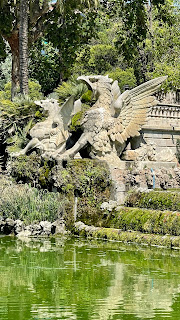I
wake up, disoriented. Hmmmmmm. Pretty room, lotsa sunshine streaming in through
the sheers. Bit foggy. Oh, yea, lotta wine. Spanish wine. Ooooh, I just woke up
in Barcelona. That’s nice. Let’s sleep 5 more.
An hour later, we wake up and it sticks this time. Pad downstairs to the very lovely patio for caffeine and the Continental. We’ll call yogurt and a Croissant a healthy breakfast, especially if we grab some of those fresh cheeses.
This
morning’s adventure is taking us to the Segrada Familia, the huge basilica most
famous for perpetually under construction. We have been in dozens and dozens of
ancient European churches - every village has one that comes up as “must do” -
and of late we’ve taken to avoiding them as they are all running together at
this point. We’re making an exception for the Segrada Familia today for two
reasons. First, we’re exploring the Eixample neighborhood today and it’s smack
dab in the middle of it. And B) it’s nine enormous towers look like giant drip
sandcastles visible from virtually everywhere in the city.
Before we go in, our guide explains that since they broke ground in 1882, they have completed 9 towers and have gone through countless contractors, budget busts and papal regimes with each leaving its mark on the project. Not to worry though, as the current contractor says that they will get the final 9 towers done in 4 years. I told Mandy that if I worked for the GC, I’d keep my resume very, very fresh.
Barcelona,
and all of Spain for that matter, celebrates their art and artists unlike
anywhere we have been. Art is woven into the fabric of everyday life, and the
larger-then-life artists are wholly reviled. The Segrada Familia was designed
by Antoni Gaudi, a favorite son of Barcelona who combined architecture and art
to spearhead the Catalan Modernism movement. Gaudi’s creations dot the city,
with the giant church in front of us as the massive exclamation point. We spend
time admiring the exterior details before passing through the 30-foot-high
doors. The inside was captivating, more airy and brighter (both lighting-wise
and less dark-gothic) then traditional European cathedrals. The ceiling of the main sanctuary is an
homage to nature, the massive columns appearing as tree trunks and the highest
windows all clear so the net effect when you look up is light filtering through
the forest canopy. The stained glass
windows – reds and oranges on one side, blues and greens on the other –
suggested sunrise and sunset and flooded the space with color. If the point of a big church is to suggest the
presence of God, the point is well taken. We finish our tour by going to the
top of the one of the towers for some birds-eye pix of the city.























No comments:
Post a Comment